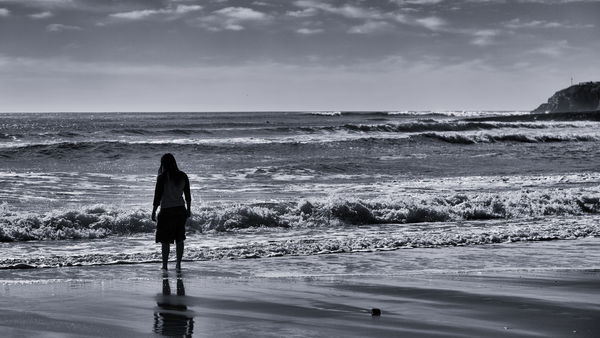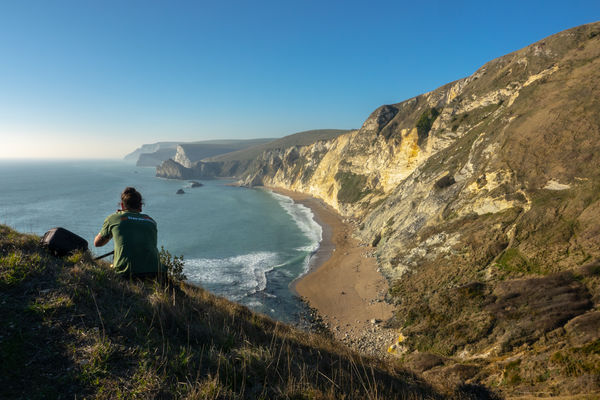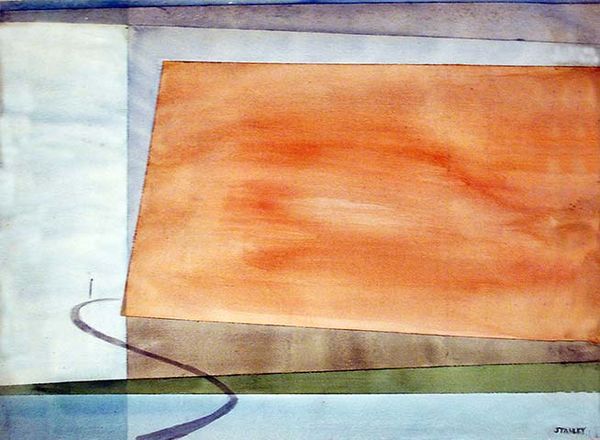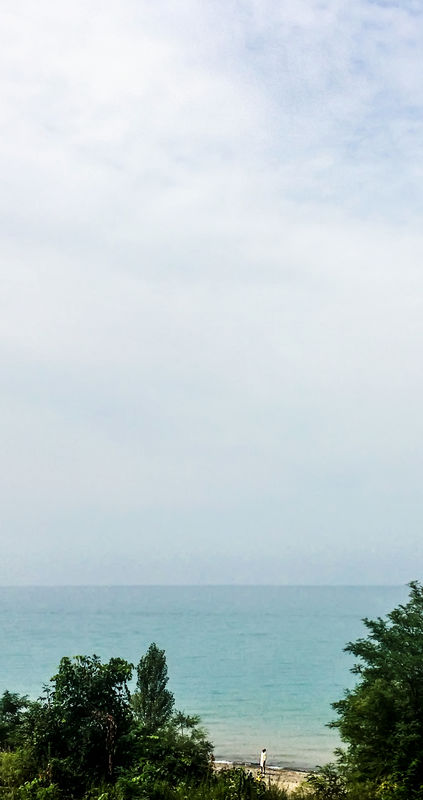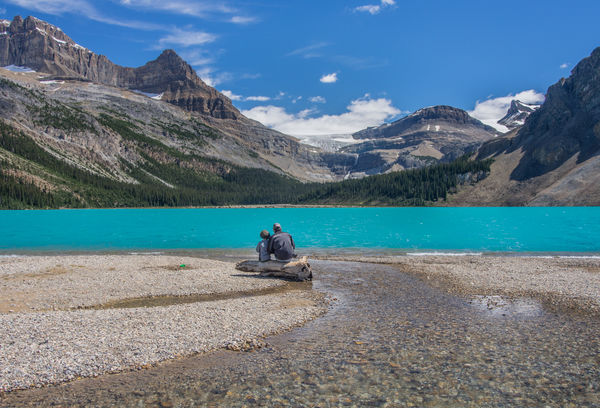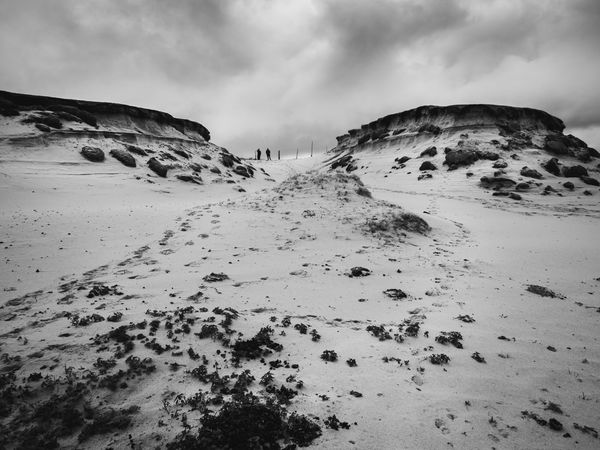Monthly Masters' Critique - Friedrich's "Wanderer Above the Sea of Fog"
Feb 28, 2019 21:03:36 #
Introduction
This month we will look at “Wanderer Above the Sea of Fog”, a painting by 19th Century German artist Caspar David Friedrich. Friedrich is categorized as a Romantic landscape painter, and is generally considered the most important German artist of his generation. He is best known for allegorical landscapes which typically feature contemplative figures silhouetted against night skies, morning mists, barren trees or Gothic or megalithic ruins. His primary interest as an artist was the contemplation of nature, and his often symbolic work seeks to convey a subjective, emotional response to the natural world. Friedrich's paintings characteristically set a human presence amid expansive landscapes, reducing the figures to a scale that, according to the art historian Christopher John Murray, directs "the viewer's gaze towards their metaphysical dimension".
Many of the figures that we see in Friedrich’s paintings are observers to a scene, shown in silhouette, or from behind, without distinguishable facial features. “Wanderer” is one of his most famous paintings, and fits into this particular convention of his. Please review some of the materials linked below for more information about Friedrich’s work, more examples from his legacy, and interesting analysis this particular painting. Then, from your perspective, share your thoughts. Here are some questions to keep in mind as you consider this artwork.
Questions To Guide Your Thinking:
1. What do you think of the composition, especially the placement of the human figure? Explain your thoughts.
2. How would you describe the color palette? How does the color palette affect the mood and message of the painting? What choices about color palette do you make as a photographer? Do you see parallels in the current interest in color grading of photographs? Is color grading something you do or have tried?
3. What is the subject of this painting? Does the painting tell a story? if so, what story do you see here?
4. What is the impact, positive or negative, of placing the figure with his back turned? Would the image be more or less effective if the viewer could see the man’s face? Would the lack of eye contact/facial features work differently if this were a photograph? Why or why not?
5. Have you taken photographs/created images with the human subject turned away from view? How would you summarize your intent when choosing compositions like this? If you’re willing, please share an image that you feel may have some connection to this approach (human figure observing something but not interacting with the photographer), and share your intent.
Links for Study:
https://www.theartstory.org/artist-friedrich-caspar-david-artworks.htm#pnt_5
https://www.artsy.net/article/artsy-editorial-unraveling-mysteries-caspar-david-friedrichs-wanderer/amp?__twitter_impression=true
http://www.artnet.com/artists/caspar-david-friedrich/
https://www.wikiart.org/en/caspar-david-friedrich
https://www.britannica.com/biography/Caspar-David-Friedrich
http://www.getty.edu/art/collection/artists/3215/caspar-david-friedrich-german-1774-1840/
https://www.artble.com/artists/caspar_david_friedrich
https://youtu.be/QJEwyARMIXI
This month we will look at “Wanderer Above the Sea of Fog”, a painting by 19th Century German artist Caspar David Friedrich. Friedrich is categorized as a Romantic landscape painter, and is generally considered the most important German artist of his generation. He is best known for allegorical landscapes which typically feature contemplative figures silhouetted against night skies, morning mists, barren trees or Gothic or megalithic ruins. His primary interest as an artist was the contemplation of nature, and his often symbolic work seeks to convey a subjective, emotional response to the natural world. Friedrich's paintings characteristically set a human presence amid expansive landscapes, reducing the figures to a scale that, according to the art historian Christopher John Murray, directs "the viewer's gaze towards their metaphysical dimension".
Many of the figures that we see in Friedrich’s paintings are observers to a scene, shown in silhouette, or from behind, without distinguishable facial features. “Wanderer” is one of his most famous paintings, and fits into this particular convention of his. Please review some of the materials linked below for more information about Friedrich’s work, more examples from his legacy, and interesting analysis this particular painting. Then, from your perspective, share your thoughts. Here are some questions to keep in mind as you consider this artwork.
Questions To Guide Your Thinking:
1. What do you think of the composition, especially the placement of the human figure? Explain your thoughts.
2. How would you describe the color palette? How does the color palette affect the mood and message of the painting? What choices about color palette do you make as a photographer? Do you see parallels in the current interest in color grading of photographs? Is color grading something you do or have tried?
3. What is the subject of this painting? Does the painting tell a story? if so, what story do you see here?
4. What is the impact, positive or negative, of placing the figure with his back turned? Would the image be more or less effective if the viewer could see the man’s face? Would the lack of eye contact/facial features work differently if this were a photograph? Why or why not?
5. Have you taken photographs/created images with the human subject turned away from view? How would you summarize your intent when choosing compositions like this? If you’re willing, please share an image that you feel may have some connection to this approach (human figure observing something but not interacting with the photographer), and share your intent.
Links for Study:
https://www.theartstory.org/artist-friedrich-caspar-david-artworks.htm#pnt_5
https://www.artsy.net/article/artsy-editorial-unraveling-mysteries-caspar-david-friedrichs-wanderer/amp?__twitter_impression=true
http://www.artnet.com/artists/caspar-david-friedrich/
https://www.wikiart.org/en/caspar-david-friedrich
https://www.britannica.com/biography/Caspar-David-Friedrich
http://www.getty.edu/art/collection/artists/3215/caspar-david-friedrich-german-1774-1840/
https://www.artble.com/artists/caspar_david_friedrich
https://youtu.be/QJEwyARMIXI
fair use: https://uploads6.wikiart.org/images/caspar-david-friedrich/the-wanderer-above-the-sea-of-fog.jpg!HD.jpg
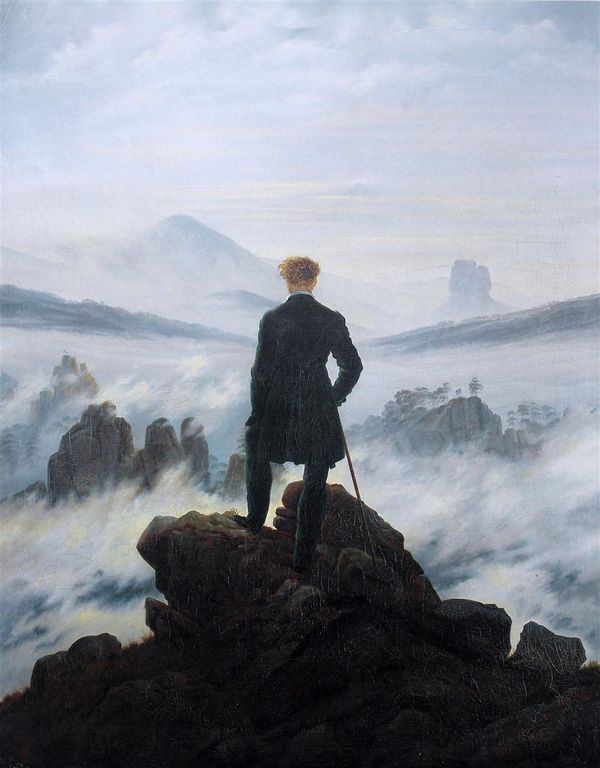
(Download)
Mar 1, 2019 10:34:10 #
To me, because the man is so prominently placed and sized, the story is man's place in nature. The man is in the center, and he is sized so that he and the scene are given, more or less, equal prominence. To me, this suggests that man has a very important role to play in the natural order.
If the man were facing the viewer, the story would change, completely. If I could see the man's face or eyes, he becomes the subject, and his place in the natural order, as a story line, becomes greatly diminished. If I see his face, the story becomes, at best, a specific man's place in the natural order, but if the man remains faceless, the story is humankind's place.
The choice of colors also contributes to the story. The colors are not particularly vibrant, which is good. Were they vibrant, that might distract from the message. The subject might actually be the vista, itself.
I do have a similar, contemplative scene, in which the subject is facing away, almost in silhouette. The faceless girl (actually, a niece) is lost in her contemplation of the vastness of the ocean. I placed her off center, because I wanted to emphasize the vastness of the ocean. I felt that, if she had been in the center, the attention might be on her, rather than on her contemplation. My choice of black and white was to de-emphasize the specific components of the picture. Color would have made me look at her, or at the ocean, or sky, rather than concentrating on her contemplative nature.
If the man were facing the viewer, the story would change, completely. If I could see the man's face or eyes, he becomes the subject, and his place in the natural order, as a story line, becomes greatly diminished. If I see his face, the story becomes, at best, a specific man's place in the natural order, but if the man remains faceless, the story is humankind's place.
The choice of colors also contributes to the story. The colors are not particularly vibrant, which is good. Were they vibrant, that might distract from the message. The subject might actually be the vista, itself.
I do have a similar, contemplative scene, in which the subject is facing away, almost in silhouette. The faceless girl (actually, a niece) is lost in her contemplation of the vastness of the ocean. I placed her off center, because I wanted to emphasize the vastness of the ocean. I felt that, if she had been in the center, the attention might be on her, rather than on her contemplation. My choice of black and white was to de-emphasize the specific components of the picture. Color would have made me look at her, or at the ocean, or sky, rather than concentrating on her contemplative nature.
Mar 1, 2019 11:40:04 #
[quote=minniev]Introduction
I find this sort of image very appealing as I love people in landscapes - and I remember your talking about changing from seeing them as a 'nuisance' to finding them a useful addition in an image, some two or three years ago Min, although we were not talking about them being quite so prominent.
I took several shots earlier this week incorporating people at one of my favourite viewpoints along our Jurassic Coast, here in Dorset, UK and post one below.
The Fredrich picture, to me, is somebody seeing 'my view' of the scene and as such is placed too centrally - I want to say 'excuse me, you're in my way!'. I'm sure it was a different statement for Freidrich - a quick Google search will bring up two or three more of his paintings that include a very central figure with their back turned. I think this one is about The Wanderer. This is where he's reached and the image shows him 'conquering' the view, like a mountaineer triumphantly reaching the summit. Interestingly, my search brought up a version of this used on the cover of a book about the artist, where the scene is cropped so that the man is well off-centre, which is somehow 'more comfortable' but loses some of the artist's intent. Other images came up in the search where the wanderer has been replaced with modern folk - the actor David Tennant, C3PO from Star Wars and Zelda all enjoying the view, although Tennant was turned to face us - that's actors for you - and it makes it a picture about him, the scene could be anywhere. I also found one with a cityscape dropped into the distance.
Figures can give scale to an image and sometimes purpose. Silhouette figures can also somehow add a bit of drama. Here's my image of The Photographer, now retitled The Wandering Photographer, which is most appropriate, as I watched him do just that along the cliff tops. I think he brings a bit of all three - scale, purpose and drama - to my shot.
I find this sort of image very appealing as I love people in landscapes - and I remember your talking about changing from seeing them as a 'nuisance' to finding them a useful addition in an image, some two or three years ago Min, although we were not talking about them being quite so prominent.
I took several shots earlier this week incorporating people at one of my favourite viewpoints along our Jurassic Coast, here in Dorset, UK and post one below.
The Fredrich picture, to me, is somebody seeing 'my view' of the scene and as such is placed too centrally - I want to say 'excuse me, you're in my way!'. I'm sure it was a different statement for Freidrich - a quick Google search will bring up two or three more of his paintings that include a very central figure with their back turned. I think this one is about The Wanderer. This is where he's reached and the image shows him 'conquering' the view, like a mountaineer triumphantly reaching the summit. Interestingly, my search brought up a version of this used on the cover of a book about the artist, where the scene is cropped so that the man is well off-centre, which is somehow 'more comfortable' but loses some of the artist's intent. Other images came up in the search where the wanderer has been replaced with modern folk - the actor David Tennant, C3PO from Star Wars and Zelda all enjoying the view, although Tennant was turned to face us - that's actors for you - and it makes it a picture about him, the scene could be anywhere. I also found one with a cityscape dropped into the distance.
Figures can give scale to an image and sometimes purpose. Silhouette figures can also somehow add a bit of drama. Here's my image of The Photographer, now retitled The Wandering Photographer, which is most appropriate, as I watched him do just that along the cliff tops. I think he brings a bit of all three - scale, purpose and drama - to my shot.
Mar 1, 2019 18:43:15 #
Anvil wrote:
To me, because the man is so prominently placed an... (show quote)
I agree with you that the posture and angle of the human figure changes everything - the subject is the contemplation and the relationship between viewer and viewed. Thank you for such a thoughtful review, and especially for sharing your own take on such a contemplative scene. It is a timeless capture.
Mar 1, 2019 18:47:15 #
[quote=magnetoman]
Thanks for sharing your thoughts and your image! I still enjoy finding people to include in a landscape scene. i’ve done a full about face on that from the days when I waited impatiently for them to leave. I still tend to keep them smaller than Friedrich’s, which dominate the frame, obviously by his intent.
minniev wrote:
b Introduction /b br br I find this sort of ima... (show quote)
Thanks for sharing your thoughts and your image! I still enjoy finding people to include in a landscape scene. i’ve done a full about face on that from the days when I waited impatiently for them to leave. I still tend to keep them smaller than Friedrich’s, which dominate the frame, obviously by his intent.
Mar 3, 2019 12:08:02 #
I am enjoying reading and seeing others' thoughts and photos of people/nature.
I recall over half a century ago, when Hillary climbed Mt. Everest, a Japanese commenting on a Western headline: "I don't understand. Hillary didn't conquer Everest, he befriended it."
My own ideas have evolved from youthful separateness (the attached early watercolor) from environment to the idea of being but a small part of the world (the small figure in the photograph).
I recall over half a century ago, when Hillary climbed Mt. Everest, a Japanese commenting on a Western headline: "I don't understand. Hillary didn't conquer Everest, he befriended it."
My own ideas have evolved from youthful separateness (the attached early watercolor) from environment to the idea of being but a small part of the world (the small figure in the photograph).
Mar 4, 2019 08:19:46 #
artBob wrote:
I am enjoying reading and seeing others' thoughts and photos of people/nature.
I recall over half a century ago, when Hillary climbed Mt. Everest, a Japanese commenting on a Western headline: "I don't understand. Hillary didn't conquer Everest, he befriended it."
My own ideas have evolved from youthful separateness (the attached early watercolor) from environment to the idea of being but a small part of the world (the small figure in the photograph).
I recall over half a century ago, when Hillary climbed Mt. Everest, a Japanese commenting on a Western headline: "I don't understand. Hillary didn't conquer Everest, he befriended it."
My own ideas have evolved from youthful separateness (the attached early watercolor) from environment to the idea of being but a small part of the world (the small figure in the photograph).
Thank you for sharing your own journey with this concept.
I spent the first 8 years of my photography journey cursing the people who intruded in my frames, and have spent the last two actively seeking them out for what they add to the story.
Mar 4, 2019 08:46:07 #
My own examples of photographing contemplation like this.
In the first, my son was explaining glaciers and such to his oldest son on a trip to the Canadian Rockies and I sneaked up behind them. (catching little boys contemplating anything requires sneaking, as they love to mug for the camera).
In the second, I was left behind by my husband and our UHH pal Graham Smith as we explored the Scottish coastal dunes of the Isle of Skye. I could see them gesturing from the top so this shot was about what I couldn't see yet, but they could.
I seek several types of contemplation shots: some of my favorites are strangers reacting to a scene I'm also reacting to, loved ones enjoying something I've taken them to see, and other photographers set up to capture a scene I'm also capturing. Such scenes let me imagine seeing through another's eyes, and the universality of our visual appreciation of the natural world.
In the first, my son was explaining glaciers and such to his oldest son on a trip to the Canadian Rockies and I sneaked up behind them. (catching little boys contemplating anything requires sneaking, as they love to mug for the camera).
In the second, I was left behind by my husband and our UHH pal Graham Smith as we explored the Scottish coastal dunes of the Isle of Skye. I could see them gesturing from the top so this shot was about what I couldn't see yet, but they could.
I seek several types of contemplation shots: some of my favorites are strangers reacting to a scene I'm also reacting to, loved ones enjoying something I've taken them to see, and other photographers set up to capture a scene I'm also capturing. Such scenes let me imagine seeing through another's eyes, and the universality of our visual appreciation of the natural world.
If you want to reply, then register here. Registration is free and your account is created instantly, so you can post right away.


